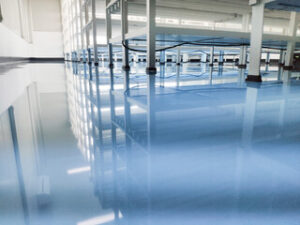Nashville Epoxy Flooring is highly durable and resists slippage, temperature fluctuations, extreme impact, and fire. They are also easy to clean and offer a unique visual effect. However, epoxy is not suitable for do-it-yourself applications and requires professional installation.

The best epoxy contractors understand the nuances underpinning each step of the process, from meticulous surface preparation to seamless application. In addition, reputable contractors offer warranties on their workmanship and materials.
Epoxy flooring is a hard-wearing, smooth floor coating that can be applied in a variety of colours and styles. It is water-resistant and provides an ideal surface for commercial kitchens, warehouses, or any room that needs a durable surface. In addition to its waterproof properties, epoxy is also stain-resistant and resists chemical spills. It can even be used with decorative chips or colored sands to create unique patterns and color schemes.
The best type of epoxy floor is 100% solids epoxy, which does not contain any water or solvents. This means that it takes a much shorter time to dry and cure than other types of floor coatings. It is also more environmentally friendly, as it produces no harmful organic vapors during curing. Additionally, 100% solids epoxy is less expensive than other types of floor coatings.
A high-quality epoxy floor can last up to 10 years or more when properly maintained. During this time, it will experience some minor fading and cracking, but these are usually cosmetic and do not affect the functionality of the floor. However, if you do want your floor to look its best for longer, you can apply a clear polyurethane topcoat to protect against fading and cracking.
Although epoxy floors are incredibly durable and long-lasting, the concrete substrate they rest on is important to the final result. The underlying floor should be free of cracks and other damage before the epoxy is applied. It is also a good idea to hire a professional contractor to carry out the required preparation.
Moreover, the concrete must be tested for moisture content, as it can cause epoxy floors to crack and degrade. This is especially true in areas with a lot of humidity, such as basements and garages. Epoxy floors are a great choice for these environments, as they help reduce the buildup of moisture and prevent mildew and mold from growing.
Once the floor is prepared and the epoxy has been applied, it will need to cure for a period of time. During this time, the floor should not be walked on or disturbed. The curing time can vary depending on a number of factors, including the temperature and humidity levels. A skilled and experienced epoxy installation team will know how to determine the correct amount of time to allow for a successful result.
Durable
Epoxy is an enduring flooring solution that can stand up to a variety of conditions. It is highly resistant to abrasion, scratches, impact, and even chemical spills. It also resists the effects of moisture and extreme temperatures.
However, like any flooring material, it has a lifespan that can be impacted by factors such as the level of wear and tear, the location of installation, and other environmental factors. Fortunately, these issues can be mitigated with proper care and maintenance.
For example, scuffing and scratching can be prevented by regularly sweeping or vacuuming and mopping with a pH-neutral cleaner. It is also recommended to use felt pads or rubber protectors under furniture legs, as they can prevent damage to the epoxy surface. Additionally, it is essential to address any damages promptly. Small chips or cracks that are left untreated can quickly escalate into a larger problem, such as water penetration.
In addition, epoxy floors are highly durable and easy to maintain. Unlike tiles, which require frequent grout cleaning and sealing, epoxy can be cleaned with simple household products. It is also more resilient against chemical spillages, which can stain other types of flooring, and can withstand temperatures up to 158 degrees Fahrenheit.
Epoxy flooring is ideal for commercial and industrial areas, as it can withstand heavy foot traffic and other abuses. It can also be a good choice for high-security areas, such as hospital wards or correctional facilities, because it is easy to clean and does not leave odors or fumes. Additionally, it is extremely fast to install and can be walked on in 24 hours, which reduces downtime for businesses.
However, epoxy floors can be susceptible to fading over time, due to UV exposure from sunlight. This can cause the floor to yellow and lose its luster, but it is not usually enough to affect functionality or safety. To avoid this, you can install a UV-absorbing topcoat, which will protect the epoxy from sun damage. Alternatively, you can have your epoxy floor re-coated periodically to keep it looking fresh. Whether your floor needs a new coating or is in need of repair, it is important to choose an experienced contractor. A reputable company will offer a warranty and guarantee their work, which can help ensure your satisfaction.
Easy to clean
Epoxy floors are extremely easy to clean, and they’re also easier to maintain than most other flooring materials. However, it’s important to keep in mind that any floor, whether epoxy or not, needs to be cleaned and cared for regularly to preserve its appearance. The first step in cleaning an epoxy floor is to sweep it daily to remove dust, sand, and other grit. This can prevent scratches and prolong the life of your epoxy. It’s also a good idea to use a vacuum cleaner or shop vac with a soft brush attachment to remove dirt from the corners and crevices of your floor.
In the case of any spills, it’s important to wipe them up immediately so they don’t soak into your floor and create permanent damage. In addition, you should avoid using any acid-based cleaners on your epoxy floor, especially citrus cleaners like lemon juice. These types of chemicals can degloss your floor and cause it to become dull over time.
If you have an epoxy floor in your garage, it’s a good idea to place a mat or plywood underneath any cars or other items that will be lifted or dropped on the floor. This will help protect the floor from scratches and dents and will prevent any damage to your vehicles or equipment.
It’s also a good idea to mop your floor once or twice a week with warm water and a pH-neutral cleaner. Regular mopping helps keep your floors looking their best and extends the life of the floor coating.
Epoxy flooring is nonporous, which means it is resistant to chemicals and other harmful substances that can easily penetrate other types of floors. This makes it a great option for facilities that frequently experience chemical spills, such as antifreeze, oil, or paint. Chemical spills should be wiped immediately, as the toxins can easily damage the substrate of your floor and cause costly damage. It’s also a good idea for facilities to invest in a chemical drain system to ensure that the chemicals are flushed from the facility and do not damage the concrete or the environment.
Easy to maintain
Installing epoxy floors is a great way to give your commercial, industrial or residential floor a beautiful finish. It can also protect the floor from damage caused by spills or flooding. However, it is important to choose a reputable contractor to ensure the quality of the installation and the materials used. It is also important to consider the cost of the project and any warranties offered by the contractor.
Proper maintenance of an epoxy floor will help to prolong its life and improve its appearance. Routine sweeping and vacuuming is recommended to remove dirt and debris from the surface. It is important to avoid using harsh cleaners that can damage the epoxy coating. Instead, use a mild soap and water solution or a neutral pH cleaner designed for epoxy flooring.
It is also a good idea to install mats or rugs in high-traffic areas. These will help to trap dirt and grime and prevent it from being compressed into the epoxy coating. You can also place plywood or mats under machinery and heavy items to reduce the risk of scratching the floor. Additionally, it is a good idea to use felt pads under bicycle and motorcycle kickstands. This will protect the epoxy from scratching and denting from sharp impacts.
Epoxy is a non-porous material, which means it can’t absorb liquids or chemicals. This makes it a very durable material that will last for years to come, even in high-traffic areas. Moreover, it is easy to clean and can be waxed to add protection.
If you notice that your epoxy floor is starting to wear or chip, it’s important to repair it promptly. These issues can lead to larger problems if left untreated. Additionally, it is important to regularly re-coat the floor to maintain its shine and durability.
Before applying the epoxy, make sure to strip any existing coatings or sealants and prepare the surface for application. Once the area is clean and dry, you can begin applying the primer. Once the primer is applied, you can mix the epoxy resin and hardener in the proper ratio and apply it to the floor.


